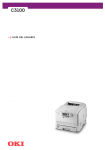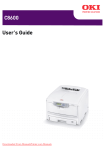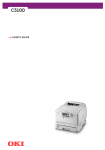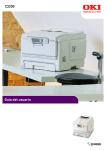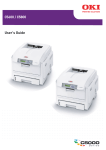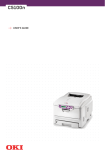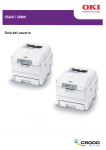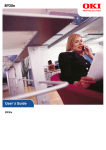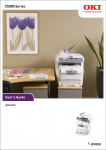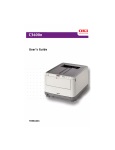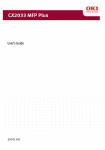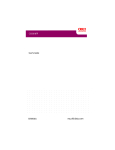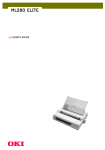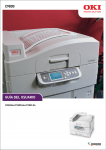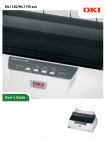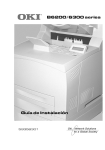Download C3200 User`s Guide - Pdfstream.manualsonline.com
Transcript
C3200 User’s Guide PREFACE Every effort has been made to ensure that the information in this document is complete, accurate, and up-to-date. The manufacturer assumes no responsibility for the results of errors beyond its control. The manufacturer also cannot guarantee that changes in software and equipment made by other manufacturers and referred to in this guide will not affect the applicability of the information in it. Mention of software products manufactured by other companies does not necessarily constitute endorsement by the manufacturer. While all reasonable efforts have been made to make this document as accurate and helpful as possible, we make no warranty of any kind, expressed or implied, as to the accuracy or completeness of the information contained herein. The most up-to-date drivers and manuals are available from the Oki Europe website: http://www.okieurope.com Copyright © 2005. All rights reserved. Oki and Microline are registered trademarks of Oki Electric Industry Company, Ltd. Energy Star is a trademark of the United States Environmental Protection Agency. Hewlett-Packard, HP, and LaserJet are registered trademarks of Hewlett-Packard Company. Microsoft, MS-DOS and Windows are registered trademarks of Microsoft Corporation. Apple, Macintosh, Mac and Mac OS are registered trademarks of Apple Computer. Other product names and brand names are registered trademarks or trademarks of their proprietors. As an Energy Star Program Participant, the manufacturer has determined that this product meets the Energy Star guidelines for energy efficiency. This product complies with the requirements of the Council Directives 89/336/EEC (EMC) and 73/23/EEC (LVD) as amended where applicable on the approximation of the laws of the member states relating to electromagnetic compatibility and low voltage. Preface> 2 CONTENTS Preface . . . . . . . . . . . . . . . . . . . . . . . . . . . . . . . . . . 2 Notes, Cautions and Warnings . . . . . . . . . . . . . . . . 5 Introduction . . . . . . . . . . . . . . . . . . . . . . . . . . . . Printer overview. . . . . . . . . . . . . . . . . . . . . . . . Front view. . . . . . . . . . . . . . . . . . . . . . . . . . Rear view . . . . . . . . . . . . . . . . . . . . . . . . . . The Status Panel . . . . . . . . . . . . . . . . . . . . . . . Switches . . . . . . . . . . . . . . . . . . . . . . . . . . . LED displays . . . . . . . . . . . . . . . . . . . . . . . . . . . . . . . . 6 . 7 . 7 . 8 . 9 10 11 Paper recommendations. . . . . . . . . . . . . . . . . . . Cassette tray . . . . . . . . . . . . . . . . . . . . . . . . . . Multi purpose tray . . . . . . . . . . . . . . . . . . . . . . Face down stacker . . . . . . . . . . . . . . . . . . . . . . Face up stacker . . . . . . . . . . . . . . . . . . . . . . . . . . . . . 14 15 15 16 16 Loading Paper. . . . . . . . . . . . . . . . . . . . . . . . . . . . 17 Cassette tray . . . . . . . . . . . . . . . . . . . . . . . . . . . 17 Multi purpose tray . . . . . . . . . . . . . . . . . . . . . . . 20 Printer settings in Windows . . . . . . . . . . . . . . . . Printer driver settings . . . . . . . . . . . . . . . . . . . . Printing preferences in Windows applications . . . . Setup tab . . . . . . . . . . . . . . . . . . . . . . . . . . Job Options tab . . . . . . . . . . . . . . . . . . . . . . Colour tab. . . . . . . . . . . . . . . . . . . . . . . . . . Setting from Windows Control Panel . . . . . . . . . . General tab . . . . . . . . . . . . . . . . . . . . . . . . . Advanced tab . . . . . . . . . . . . . . . . . . . . . . . . . . . . . . . . 21 21 21 22 23 24 25 25 26 Colour Printing . . . . . . . . . . . . . . . . . . . . . . . . . . Factors that affect the appearance of prints. . . . . Tips for printing in colour . . . . . . . . . . . . . . . . . Printing photographic images . . . . . . . . . . . . Printing from Microsoft Office applications. . . . Printing specific colours (e.g. a company logo) . . . . . . . . . . . . . . . . . . . . . . . . . . . . Adjusting the brightness or intensity of a print . . . . . . . . . . . . . . . . . . . . . . . . . . . . . Accessing the colour matching options . . . . . . . . Setting the colour matching options . . . . . . . . . . Using the Colour Swatch feature . . . . . . . . . . . . Using the Colour Correct Utility . . . . . . . . . . . . . . . . . . 28 28 30 30 30 Preface> 3 . 30 . . . . . 30 31 31 33 34 The Status Monitor . . . . . . . . . . . . . . . . . . . . . . . Using the Status Monitor . . . . . . . . . . . . . . . . . . Printer State tab . . . . . . . . . . . . . . . . . . . . . Printer Setup tab . . . . . . . . . . . . . . . . . . . . . Preferences tab . . . . . . . . . . . . . . . . . . . . . . Printer functions (User Settings) . . . . . . . . . . . . Information menu . . . . . . . . . . . . . . . . . . . . Print menu . . . . . . . . . . . . . . . . . . . . . . . . . Media menu . . . . . . . . . . . . . . . . . . . . . . . . Colour menu . . . . . . . . . . . . . . . . . . . . . . . . System configuration menu . . . . . . . . . . . . . USB menu . . . . . . . . . . . . . . . . . . . . . . . . . Memory menu . . . . . . . . . . . . . . . . . . . . . . . System adjustment menu . . . . . . . . . . . . . . . Maintenance menu. . . . . . . . . . . . . . . . . . . . Usage menu . . . . . . . . . . . . . . . . . . . . . . . . Printing settings . . . . . . . . . . . . . . . . . . . . . Changing the display language . . . . . . . . . . . . . . . . . . . . . . . . . . . . . 35 35 36 36 39 40 40 40 41 44 45 46 47 47 48 49 50 50 Replacing consumable items . . . . . . . . . . . . . . . Consumable order details . . . . . . . . . . . . . . . . . Toner cartridge replacement . . . . . . . . . . . . . . . Image drum replacement . . . . . . . . . . . . . . . . . Replacing the belt unit . . . . . . . . . . . . . . . . . . . Fuser replacement . . . . . . . . . . . . . . . . . . . . . . Cleaning the LED head . . . . . . . . . . . . . . . . . . . . . . . . . . 51 52 53 59 62 65 68 Installing additional memory . . . . . . . . . . . . . . . . 69 Order codes. . . . . . . . . . . . . . . . . . . . . . . . . . . . 69 Memory upgrade . . . . . . . . . . . . . . . . . . . . . . . . 69 Clearing paper jams . . . . . . . . . . . . . . . . . . . . . . . 73 Specifications . . . . . . . . . . . . . . . . . . . . . . . . . . . . 81 Index . . . . . . . . . . . . . . . . . . . . . . . . . . . . . . . . . . 82 Oki contact details . . . . . . . . . . . . . . . . . . . . . . . . 84 Preface> 4 NOTES, CAUTIONS AND WARNINGS NOTE A note provides additional information to supplement the main text which may help you to use and understand the product. CAUTION! A caution provides additional information which, if ignored, may result in equipment malfunction or damage. WARNING! A warning provides additional information which, if ignored, may result in a risk of personal injury. Notes, Cautions and Warnings> 5 INTRODUCTION Congratulations on buying this Oki colour printer. Your new printer is designed with advanced features to give you clear, vibrant colour prints and crisp black and white pages at high speed on a range of office print media. Your printer includes these features: > Up to 12 pages per minute in full colour for fast printing of high impact colour presentations and other documents > Up to 20 pages per minute in black and white for fast and efficient printing of all general purpose documents not requiring colour > 1200 x 600dpi (dots per inch) print resolution for high quality image production showing the finest detail > Single Pass Colour Digital LED technology for high speed processing of your printed pages > High speed USB 2.0 interface > Photo Enhance mode to improve printouts of photographic images > “Ask Oki” – a brand new, user-friendly function that gives a direct link from your printer driver screen (but not always illustrated in this guide) to a dedicated web site specific to the exact model you are using. This is where you’ll find all the advice, assistance and support you could need to help you get the best possible results from your Oki printer. Additionally, the following optional feature is available: > Additional memory, to allow printing of more complex pages. Introduction> 6 PRINTER OVERVIEW FRONT VIEW 1 2 3 2 7 4 6 5 1. Output stacker, face down. Standard printed copy delivery point. Holds up to 250 sheets at 80g/m². 2. Multi purpose feeder release (2) (press). 3. Status Panel. Status LEDs and operator buttons. 5. Paper tray. Standard blank paper tray. Holds up to 300 sheets of 80g/m² paper. 6. Multi purpose feeder (shown closed). Used for feeding heavier paper stocks, envelopes and other special media. Also for manual feeding of single sheets when required. 7. ON/OFF switch. 4. Front Cover release (lift). Introduction> 7 REAR VIEW This view shows the connection panel and the rear output stacker. 10 8 9 8. USB interface. (USB cable must be of length 2m maximum for reliable Status Monitor operation.) 10. Rear, face up, 100 sheet stacker. 9. AC power socket. When the rear paper stacker is folded down, paper exits through the rear of the printer and is stacked here face up. This is mainly used for heavy print media. When used in conjunction with the multi purpose feed tray, the paper path through the printer is essentially straight. This avoids bending the paper around curves in the paper path and enables feeding of up to 203g/m² media. Introduction> 8 THE STATUS PANEL The Status Panel allows operator intervention and indicates both when the printer is operating normally and when it requires attention. Detailed printer status is provided by the Status Monitor. (See “Using the Status Monitor” on page 35.) 1 2 3 4 5 6 The Status Panel incorporates 4 LEDs and 2 push-button switches as follows: 1. Power (Ready) LED (green) 2. Paper LED (amber) 3. Consumable LED (amber) 4. Alarm LED (amber) 5. ON LINE switch 6. CANCEL switch The switches enable printer operation while the LEDs display the status of the printer operation. Introduction> 9 SWITCHES Operation The switches are labelled ON LINE and CANCEL and each has three modes of operation as follows: MODE OF OPERATION DESCRIPTION Momentary press Press the switch and release it within 2 seconds of (Press 1) pressing it. The operation starts immediately the switch is released. 2-second press (Press 2) 5-second press (Press 5) Press the switch and release it between2 and 5 seconds after pressing it. The operation starts immediately the switch is released (except at job cancellation). Press the switch and hold it for 5 seconds or more. The operation starts 5 seconds after pressing the switch, even if you hold it pressed for more than 5 seconds. Function The results of operating the switches in different contexts are summarised below. STATUS BEFORE PRESSING ONLINE SWITCH PRESS 1 CANCEL SWITCH PRESS PRESS 2 5 PRESS 1 PRESS PRESS 2 5 ON LINE (idling mode) Shifts to OFF LINE Prints Menu Map (*1) Prints Demo Print – – – OFF LINE (idling mode) Shifts to ON LINE Prints Menu Map (*2) prints Demo Print (*2) – – – – Cancels job – Shifts to ON LINE (data being OFF LINE received, processing or printing) – – (*3) Introduction> 10 STATUS BEFORE PRESSING ONLINE SWITCH PRESS 1 CANCEL SWITCH PRESS PRESS 2 5 Requesting Starts manual paper feed, no supply paper in MP Tray or paper size mismatch – – – – – – – – No paper in Tray 1 or Tray 1 open – PRESS PRESS 2 5 Cancels job – (*3) Cancels job – (*3) Memory Recovers overflow or from the invalid data error and shifts to ON LINE Paper jam At cover open/close after the waste toner has become full – PRESS 1 – – – – – – – – Recognises the toner has been changed – – Recognises the toner has not been changed – – *1: The Menu Map (or Status Page) provides details of printer settings and status information. *2: Shifts to ON LINE after printing has started. *3: Executes job cancellation 2 seconds after start of switch operation (even if the switch is held down longer). LED DISPLAYS General Printer status (as indicated by the LEDs) can be broadly categorised as follows: 1. Normal status: the printer is operating normally e.g. it is ON LINE or processing. 2. Warning status: you can continue to use the printer without intervention but an error may result. Introduction> 11 3. Error status: you cannot continue to use the printer. Intervention is required to recover from the error. Fatal errors are irrecoverable and require a service call. When several different status situations occur concurrently, only the status with the highest priority is displayed on the LEDs. Warning status combined with the highest-priority normal status is displayed on the LEDs. Function A summary of the functions of each LED is given below: LED FUNCTION Power (Ready) Indicates POWER ON, ON LINE, OFF LINE, power saving, data receiving, printing, job cancelling, warming up, density adjustment/temperature adjustment in progress Paper Indicates paper out warning/alarm, manual feed request Consumable Indicates consumables life warning/alarm, consumables installation error Alarm Indicates paper jam, cover open error Illumination and meaning To be able to indicate a large number of status situations both individually and in combination, the LEDs are illuminated as follows: LED Power (Ready) Green ILLUMINATION STATUS OFF Power OFF ON ON LINE (idle) Blinking 1 (2S cycle) OFF LINE (this blinking pattern always takes place while an error is occurring) Blinking 2 (500mS cycle) Data being received, printing, warming up, density adjustment/temperature adjustment in progress Blinking 3 (120mS cycle) Job cancelling in progress Blinking 4 (4.5S ON and 500mS OFF) Power saving mode Introduction> 12 LED ILLUMINATION STATUS OFF ON LINE ON A warning is indicated (printing possible) Blinking 1 (2S cycle) An error has occurred but printing can continue if you press the ON LINE or CANCEL switch. Paper, Consumable, Blinking 2 (500mS cycle) An error has occurred. You need to replace consumables Alarm or remove jammed paper, for (Amber) example. The printer then recovers from the error and printing becomes possible again. Blinking 3 (120mS cycle) A serious error has occurred. rebooting or a service call is required. The Status Monitor provides a readable description of the printer status corresponding to the indications of the LEDs. If you have the Status Monitor Preferences set to Pop up on alerts, this readable message will be presented on screen whenever an abnormal condition occurs. Introduction> 13 PAPER RECOMMENDATIONS Your printer will handle a variety of print media, including a range of paper weights and sizes, transparencies and envelopes. This section provides general advice on choice of media, and explains how to use each type. The best performance will be obtained when using standard 75~90g/m² paper designed for use in copiers and laser printers. Suitable types are: • Arjo Wiggins Conqueror Colour Solutions 90g/m²; • Colour Copy by Neusiedler. Use of heavily embossed or very rough textured paper is not recommended. Pre-printed stationery can be used, but the ink must not offset when exposed to the high fuser temperatures used in the printing process. Envelopes should be free from twist, curl or other deformations. They should also be of the rectangular flap type, with glue that remains intact when subjected to hot roll pressure fusing used in this type of printer. Window envelopes are not suitable. Transparencies should be of the type designed for use in copiers and laser printers. We strongly recommend Oki transparencies (Order No. 01074101). In particular, avoid office transparencies designed for use by hand with marker pens. These will melt in the fuser and cause damage. Labels should also be of the type recommended for use in copiers and laser printers, in which the base carrier page is entirely covered by labels. Other types of label stock may damage the printer due to the labels peeling off during the printing process. Suitable types are: • Avery White Laser Label types 7162, 7664, 7666 (A4), or 5161 (Letter); • Kokuyo A693X series (A4) or A650 (B5). Business cards recommended are produced by Oki (Order No. 09002985). Paper recommendations> 14 CASSETTE TRAY SIZE DIMENSIONS A6 105 x 148mm A5 148 x 210mm B5 182 x 257mm Executive 184.2 x 266.7mm A4 210 x 297mm Letter 215.9 x 279.4mm Legal 13in. 216 x 330mm Legal 13.5in. 216 x 343mm Legal 14in. 216 x 356mm WEIGHT (G/M²) Light 64-74g/m² Medium 75-90g/m² Heavy 91-120g/m² If you have identical paper stock loaded in the multi purpose tray, you can have the printer automatically switch to the other tray when the current tray runs out of paper. When printing from Windows applications, this function is enabled in the driver settings. (See “Printer settings in Windows” on page 21.) When printing from other systems, this function is enabled in the Print Menu. (See “Printer functions (User Settings)” on page 40.) MULTI PURPOSE TRAY The multi purpose tray can handle the same media sizes as the cassette trays but in weights of 75g/m² to 203g/m². For very heavy paper stock, use the face up (rear) paper stacker. This ensures that the paper path through the printer is almost straight. The multi purpose tray can feed paper widths as small as 105mm and lengths up to 1200mm (banner printing). For paper lengths exceeding 356mm (Legal 14in.) use paper stock between 90g/m² and 128g/m² and the face up (rear) paper stacker. Use the multi purpose tray for printing on envelopes and transparencies. Up to 50 sheets of transparencies or 10 envelopes can be loaded at one time, subject to a maximum stacking depth of 10mm. Paper or transparencies should be loaded print side up and top edge into the printer. Paper recommendations> 15 FACE DOWN STACKER The face down stacker on the top of the printer can hold up to 250 sheets of 80g/m² standard paper and can handle paper stocks up to 120g/m². Pages printed in reading order (page 1 first) will be sorted in reading order (last page on top, facing down). FACE UP STACKER The face up stacker at the rear of the printer should be opened and the tray extension pulled out when required for use. In this condition paper will exit via this path, regardless of driver settings. The face up stacker can hold up to 100 sheets of 80g/m² standard paper, and can handle stocks up to 203g/m². Always use this stacker and the multi purpose feeder for paper stocks heavier than 120g/m². Paper recommendations> 16 LOADING PAPER CASSETTE TRAY 1. Remove the paper tray from the printer. 2. Fan the paper to be loaded at the edges (1) and in the middle (2) to ensure that all sheets are properly separated, then tap the edges of the stack on a flat surface to make it flush again (3). 1 2 Loading Paper> 17 3 3. Load the paper (for letter headed paper load face down with top edge towards the front of the printer). 1 4. 2 Adjust the rear stopper (1) and paper guides (2) to the size of paper being used. To prevent paper jams: • Do not leave space between the paper and the guides and rear stopper. • Do not overfill the paper tray. Capacity depends on the type of paper stock. • Do not load damaged paper. • Do not load paper of different sizes or types at the same time. • Do not pull the paper tray out during printing. • Close the paper tray gently. Loading Paper> 18 5. For face down printing, make sure the face up (rear) stacker (3) is closed (the paper exits from the top of the printer). Stacking capacity is approximately 250 sheets, depending on paper weight. 6. For face up printing, make sure the face up (rear) stacker (3) is open and the paper support (4) is extended. Paper is stacked in reverse order and tray capacity is approximately 100 sheets, depending on paper weight. 7. Always use the face up (rear) stacker for heavy paper (card stock etc.). 3 4 CAUTION! Do not open or close the rear paper exit while printing as it may result in a paper jam. Loading Paper> 19 MULTI PURPOSE TRAY 1. Open the multi purpose tray and press gently down on the paper platform (1) to ensure it is latched down. 1 3 2 2. 3. Load the paper and adjust the paper guides (2) to the size of paper being used. • When printing on headed paper load the paper into the multi purpose tray with pre-printed side up and top edge into the printer. • Envelopes should be loaded face up with top edge to the left and short edge into the printer. • Do not exceed the paper capacity of about 50 sheets or 10 envelopes. Maximum stacking depth is 10mm. Press the tray latch button (3) inwards to release the paper platform, so that the paper is lifted and gripped in place. Set the correct paper size for the multi purpose tray in the Media Menu. (See “Printer functions (User Settings)” on page 40.) Loading Paper> 20 PRINTER SETTINGS IN WINDOWS Your printer’s menus (accessed via the “The Status Monitor” on page 35) provide access to many options. The Windows printer driver also contains settings for many of these items. Where items in the printer driver are the same as those in the menus, and you print documents from Windows, the settings in the Windows printer driver will override those items in the menus. The illustrations in this chapter show Windows XP. Other Windows versions may appear slightly different, but the principles are the same. PRINTER DRIVER SETTINGS You can make printer driver settings either from Windows Printers window (called “Printers and Faxes” in Windows XP) or from within a Windows application. The driver settings you make from Windows are essentially default settings and will be remembered from one Windows session to the next. The driver settings you make from within a Windows application are those required for a particular job. In both cases, you can save and name (on the Setup tab) specific sets of driver settings which can be recalled for future use. PRINTING PREFERENCES IN WINDOWS APPLICATIONS When you choose to print your document from a Windows application program a Print dialogue box appears. This dialogue usually specifies the name of the printer on which you will print your document. Next to the printer name is a Properties button. Printer settings in Windows> 21 When you click Properties a new window opens which contains a short list of the printer settings available in the driver, which you can choose for this document. The settings available from within your application are only those which you may want to change for specific applications or documents. Settings you change here will usually only last for as long as the particular application program is running. SETUP TAB When you click the Properties button from your application’s Print dialogue, the driver window opens to allow you to specify your printing preferences for the current document. 1. 1 2 3 4 Paper size should be the same as the page size of 5 your document (unless you wish to scale the printout to fit another size), and should also be the same as the size of paper you will feed into the printer. 6 2. You can choose the source of the paper to feed, which may be Tray 1 (the standard paper tray) or the multi purpose feeder. You can also click on the appropriate part of the screen graphic to select your preferred tray. 3. The setting for paper weight should match the type of paper on which you intend to print. 4. A variety of document finishing options can be selected, such as normal one page per sheet, or N-up (where N can be a maximum of 16) for printing scaled down pages at more than one page per sheet. Poster printing will print large pages as tiles spread over multiple sheets. 5. If you have changed some printing preferences before and saved them as a set, you can recall them to avoid having to set them individually each time you need them. 6. A single on-screen button restores the default settings. Printer settings in Windows> 22 JOB OPTIONS TAB 3 4 1 5 2 7 8 1. The output resolution of the printed page can be set as follows. • The highest quality setting prints at 1200 x 600dpi. This option requires the most printer memory and takes the longest to print. • The normal setting prints at 600 x 600dpi and is adequate for all but the most discerning applications. • The draft setting prints at 300 x 300dpi and is suitable for draft documents, where print quality is less critical. 2. You can print watermark text behind the main page image. This is useful for marking documents as draft, confidential, etc. 3. You can select up to 999 copies to print consecutively, although you will need to top up the paper tray during such a long print run. 4. Page orientation can be set to either portrait (tall) or landscape (wide). 5. Your printed pages can be scaled to fit larger or smaller stationery. 6. Clicking the Advanced button gives you access to further settings. For example, you can elect to have black areas printed using 100%K toner (a more matte appearance). 7. A single on-screen button restores the default settings. 8. The quality of photographic images can be improved. Printer settings in Windows> 23 COLOUR TAB 1 2 4 3 5 1. Control over the colour output of your printer may be performed automatically, or for advanced control, by manual adjustment. The automatic setting will be appropriate in most cases. The other options in this window only become visible when you select a choice other than Auto. For grayscale printing, the printer runs at 20ppm and all pages are printed in black and white. 2. You can choose from a range of colour matching options, depending on the image source for your document. For example, a photograph taken on a digital camera might require different colour matching from a business graphic created in a spreadsheet application. Again, for most general purpose use, Auto is the best choice. 3. Printed output may be made lighter or darker, or the colours made more saturated and vibrant as required. 4. Black areas may be printed using 100% cyan, magenta and yellow, giving a more glossy appearance (composite black), or using only black toner (true black), giving a more matte appearance. Choosing the Auto setting allows the driver to make the most appropriate choice based on image content. 5. A single on-screen button restores the default settings. Printer settings in Windows> 24 SETTING FROM WINDOWS CONTROL PANEL When you open the driver properties window directly from Windows, rather than from within an application program, a somewhat more extensive range of settings is provided. Changes made here will generally affect all documents you print from Windows applications, and will be remembered from one Windows session to the next. GENERAL TAB 1 2 3 1. This area lists some of the main features of your printer. 2. This button opens the same windows as described earlier for items which can be set from within application programs. Changes you make here, however, will become the new default settings for all Windows applications. 3. This button prints a test page to ensure that your printer is working. Printer settings in Windows> 25 ADVANCED TAB 1 2 3 4 5 6 7 8 9 10 12 11 1. You can specify which times of day your printer will be available. 2. Indicates current priority, from 1 (lowest) to 99 (highest). Highest priority documents will print first. 3. Specifies that documents should be spooled (stored in a special print file) before being printed. The document is then printed in the background, allowing your application program to become available more quickly. 4. This specifies that printing should not start until the last page has been spooled. If your application program needs a lot of time for further computation in the middle of printing, causing the print job to pause for more than a short period, the printer could prematurely assume that the document has finished. Selecting this option would prevent that situation, but printing will be completed a little later, as the start is delayed. 5. This is the opposite choice to the one above. Printing starts as soon as possible after the document begins spooling. 6. This specifies that the document should not be spooled, but printed directly. Your application will not normally be ready for further use until the print job is complete. This requires less disk space on your computer, since there is no spool file. 7. Directs the spooler to check the document setup and match it to the printer setup before sending the document to print. If a mismatch is detected, the document is held Printer settings in Windows> 26 in the print queue and does not print until the printer setup is changed and the document restarted from the print queue. Mismatched documents in the queue will not prevent correctly matched documents from printing. 8. Specifies that the spooler should favour documents which have completed spooling when deciding which document to print next, even if completed documents are lower priority than documents which are still spooling. If no documents have completed spooling, the spooler will favour larger spooling documents over shorter ones. Use this option if you want to maximise printer efficiency. When this option is disabled the spooler chooses documents based only on their priority settings. 9. Specifies that the spooler should not delete documents after they are completed. This allows documents to be resubmitted to the printer from the spooler instead of printing again from the application program. If you use this option frequently it will require large amounts of disk space on your computer. 10. Specifies whether advanced features, such as page order and pages per sheet, are available, depending on your printer. For normal printing keep this option enabled. If compatibility problems occur you can disable the feature. However, these advanced options may then not be available, even though the hardware might support them. 11. This button provides access to the same setup windows as when printing from applications. Changes made via the Windows Control Panel become the Windows default settings. 12. You can design and specify a separator page that prints between documents. (This is particularly useful on a shared printer to help each user find their own documents in the output stack.) Printer settings in Windows> 27 COLOUR PRINTING The printer drivers supplied with your printer provide several controls for changing the colour output. For general use the automatic settings will suffice, providing reasonable default settings that will produce good results for most documents. Many applications have their own colour settings, and these may override the settings in the printer driver. Please refer to the documentation for your software application for details on how that particular program’s colour management functions. FACTORS THAT AFFECT THE APPEARANCE OF PRINTS If you wish to manually adjust the colour settings in your printer driver, please be aware that colour reproduction is a complex topic, and there are many factors to take into consideration. Some of the most important factors are listed below. Differences between the range of colours a monitor or printer can reproduce > Neither a printer nor a monitor is capable of reproducing the full range of colours visible to the human eye. Each device is restricted to a certain range of colours. In addition to this, a printer cannot reproduce all of the colours displayed on a monitor, and vice versa. > Both devices use very different technologies to represent colour. A monitor uses Red, Green and Blue (RGB) phosphors (or LCDs), a printer uses Cyan, Magenta, Yellow and Black (CMYK) toner or ink. > A monitor can display very vivid colours such as intense reds and blues and these cannot be easily produced on any printer using toner or ink. Similarly, there are certain colours, (some yellows for example), that can be printed, but cannot be displayed accurately on a monitor. This disparity between monitors and printers is often the main reason that printed colours do not match the colours displayed on screen. Colour Printing> 28 Viewing conditions A print can look very different under different lighting conditions. For example, the colours in a print may look different when viewed standing next to a sunlit window, compared to how they look under standard office fluorescent lighting. Printer driver colour settings The driver settings for Manual colour can change the appearance of a print. There are several options available to help match the printed colours with those displayed on screen. Monitor settings The brightness and contrast controls on your monitor can change how your document looks on-screen. Additionally, your monitor’s colour temperature influences how “warm” or “cool” the colours look. There are several settings found on a typical monitor: > 5000k Warmest; yellowish lighting, typically used in graphic art environments. > 6500k Cooler; approximates daylight conditions. > 9300k Cool; the default setting for many monitors and television sets. (k = degrees Kelvin, a measurement of temperature.) How your software application displays colour Some graphics applications such as Corel Draw or Adobe Photoshop may display colour differently from “Office” applications such as Microsoft Word. Please see your application’s on-line help or user manual for more information. Paper type The type of paper used can also significantly affect the printed colour. For example, a printout on recycled paper can look duller than one on specially formulated glossy paper. Colour Printing> 29 TIPS FOR PRINTING IN COLOUR The following guidelines may help you to achieve good colour output from your printer. PRINTING PHOTOGRAPHIC IMAGES Use the Monitor (6500k) Perceptual setting. If the colours look too dull, try the Monitor (6500k) Vivid or Digital Camera settings. PRINTING FROM MICROSOFT OFFICE APPLICATIONS Use the Monitor (9300k) setting. This may help if you are having problems with specific colours from applications such as Microsoft Excel or Microsoft Powerpoint. PRINTING SPECIFIC COLOURS (E.G. A COMPANY LOGO) There are 2 utilities on your printer driver CD-ROM that can help match specific colours: Colour Correct Utility Colour Swatch Utility ADJUSTING THE BRIGHTNESS OR INTENSITY OF A PRINT If the print is too light/dark, you can use the Brightness control to adjust it. If the colours are too intense/not intense enough, use the Saturation control. Colour Printing> 30 ACCESSING THE COLOUR MATCHING OPTIONS The Colour Matching options in the printer driver can be used to help match your printed colours to the ones displayed on your monitor or from some other source, such as a digital camera. To open colour matching options from the Windows Control Panel: 1. Open the Printers window (called “Printers and Faxes” in Windows XP). 2. Right-click the printer name and choose Properties. 3. Click the Printing Preferences button (1). 1 To open colour matching options from within a Windows application: 1. Choose File—Print… from the application’s menu bar. 2. Click the Properties button next to the printer name. SETTING THE COLOUR MATCHING OPTIONS 1. On the Colour tab select Advanced Colour ((1) below) for Colour Matching. Colour Printing> 31 2. Choose the Manual colour setting (2) and select from the following options: 1 b c d a 2 e (a) Monitor (6500k) Perceptual Optimised for printing photographs. Colours are printed with emphasis on saturation. (b) Monitor (6500k) Vivid Optimised for printing photographs, but with even more saturated colours than the Monitor (6500k) Perceptual setting. (c) Monitor (9300k) Optimised for printing graphics from applications such as Microsoft Office. Colours are printed with emphasis on Lightness. (d) Digital Camera Optimised for printing photographs taken with a digital camera. Your results will vary depending on the subject and the conditions under which the photograph was taken. (e) sRGB The printer will try to reproduce the sRGB colour space. This may be useful if colour matching from an sRGB input device such as a scanner or digital camera. Colour Printing> 32 USING THE COLOUR SWATCH FEATURE To use the Colour Swatch feature, you must install the Colour Swatch Utility. This is supplied on the CD-ROM that was supplied with your printer. The Colour Swatch function prints charts which contain a range of sample colours. Note that this is not the full range of colours that the printer can produce. Listed on each sample colour are the corresponding RGB (Red, Green, Blue) values. This can be used to pick specific colours in applications that allow you to choose your own RGB values. Simply click the Colour Swatch button (1) and choose from the options available. 1 An example of using the Colour Swatch function: You wish to print a logo in a particular shade of red. The steps you would follow are: 1. Print a colour swatch, then select the shade of red that best suits your needs. 2. Take a note of the RGB value for the particular shade that you liked. 3. Using your program’s colour picker, enter these same RGB values, and change the logo to that colour. The RGB colour displayed on your monitor may not necessarily match what was printed on the colour swatch. If this is the case, it is probably due to the difference between how your monitor and printer reproduce colour. Here, it is unimportant since your primary objective is to print the required colour. Colour Printing> 33 USING THE COLOUR CORRECT UTILITY The Oki Colour Correct Utility is provided on your printer driver CD-ROM. You must install it separately since it is not installed along with the printer driver. The Colour Correct utility has the following features: > Microsoft Office palette colours can be individually adjusted. This is useful if you want to change how a specific colour is printed. > Colours can be adjusted by changing Hue, Saturation and Gamma. This is useful if you wish to change the overall colour output. Once these colour adjustments have been made, the new settings can be selected from the printer driver Colour tab. To select adjustments made with the Colour Correct Utility: 1. From your application program, click File and point to Print. 2. Click Properties. This displays the printer driver options. 3. Click the Colour tab. 4. Click Advanced Colour. 5. Click User Defined. Select the colour adjustment you made with the Colour Correct Utility. Colour Printing> 34 THE STATUS MONITOR The Status Monitor software is distinct from and installed separately from the driver software. NOTE For reliable operation of the Status Monitor, ensure that the USB cable is of length 2m maximum. The Status Monitor provides a readable indication of the printer status as displayed on the indicator LEDs on the Status Panel (See “The Status Panel” on page 9.) and allows you to access the printer menus (listed at the end of this chapter) to set printer parameters such as paper size etc. USING THE STATUS MONITOR NOTE You are advised to refer to the extensive on-line help as required when using the Status Monitor. Viewing the status of the printer, and viewing or changing the printer menu settings are carried out as follows: 1. Click on [Start], [All Programs] and select Okidata|OKI C3200|Printer Name Status Monitor. The current printer status is shown. The Status Monitor> 35 2. Click on the window maximise button and the view will expand to include the Printer State, Printer Setup and Preferences tabs. PRINTER STATE TAB This tab is visible by default on opening the Status Monitor and displays detailed information about the status of the printer. PRINTER SETUP TAB Selecting this tab provides access to the Printer Settings button, which, when selected, enables you to configure the printer settings. The Status Monitor> 36 User Settings This tab is intended to be used for normal day-to-day use by any user. The User Settings tab has the menu items on the left and allows you to configure a selected setting on the right. Click the Save button to save the new setting or the Undo button to undo the change. Use File|Exit to return to the Printer Setup Tab. Administrator Settings This tab is intended to be used only by designated staff. When you click on the Administrator Settings tab, an alert pops up to remind you to take care as changing settings here may affect the operation of your printer. The Administrator Settings tab has the settable items, including access to the user menus, on the left and allows you to configure a selected setting on the right. If you disable a menu from this tab, it does not appear on the User Settings tab. The Status Monitor> 37 Click the Save button to save the new setting or the Undo button to undo the change. Use File|Exit to return to the Printer Setup Tab. NOTE You can access the printer menu settings window direct by clicking [Start], [All Programs] and selecting Okidata|OKI C3200|Printer Name Printer Settings. The Status Monitor> 38 PREFERENCES TAB Selecting this tab provides the means to choose the information displayed by the Status Monitor and how/when the Status Monitor appears. The default Alert view setting (Pop up on alerts) ensures that the Status Monitor pops up to inform you of a condition that requires your attention e.g. a missing or badly fitted toner cartridge. The Status Monitor> 39 PRINTER FUNCTIONS (USER SETTINGS) The printer settings made from the Status Monitor can be seen collectively on a printed Menu Map (or Status Page). (For details of how to print such a map, see the next section.) It should be noted that many of these settings can be, and often are, overridden by settings made in the printer drivers. However, several of the driver settings can be left at “Printer Setting”, which will then default to the settings entered in these printer menus. Factory default settings are shown in bold type in the following tables. INFORMATION MENU This menu provides a quick method of listing various items stored within the printer. INFORMATION MENU ITEM ACTION EXPLANATION PRINT MENU MAP EXECUTE Prints complete menu listing with current settings shown. DEMO1 EXECUTE Prints demo page. PRINT MENU This menu provides adjustment of various print job related functions. PRINT MENU ITEM SETTINGS EXPLANATION COPIES 1-999 Enter the number of copies of a document to be printed from 1 to 999. PAPER FEED TRAY1 MP TRAY Selects the default tray for paper feed, Tray 1 or MP Tray (multi purpose tray). AUTO TRAY SWITCH ON/OFF Turns Auto Tray Switch function ON or OFF. TRAY SEQUENCE DOWN UP Select Tray Sequences of Auto Tray Select and Auto Tray Switch PAPER FEED TRAY The Status Monitor> 40 PRINT MENU ITEM SETTINGS EXPLANATION MP TRAY USAGE DO NOT USE WHEN MISMATCH If a document to be printed demands a paper size not installed in the selected tray, the printer can automatically feed from the multi purpose tray instead. If this function is not enabled, the printer will stop and request the correct size of paper to be loaded. MEDIA CHECK ENABLE DISABLE Determines whether the printer checks the size of paper loaded matches that required for the document sent to print. MONO-PRINT SPEED AUTO COLOUR SPEED NORMAL SPEED Selects the printer's print engine speed for the type of print media in use. MEDIA MENU This menu provides adjustment to suit a wide range of print media. MEDIA MENU ITEM SETTINGS EXPLANATION TRAY1 PAPERSIZE A4 / A5 / A6 / B5 LEGAL14 LEGAL13.5 LEGAL13 LETTER EXECUTIVE CUSTOM Selects the size of paper loaded in Tray 1. For CUSTOM setting see X-DIMENSION and Y-DIMENSION later in this table. The Status Monitor> 41 MEDIA MENU ITEM SETTINGS EXPLANATION TRAY1 MEDIATYPE PLAIN LETTERHEAD BOND RECYCLED ROUGH USERTYPE1 – 5 Selects the type of media loaded in this tray. This will help the printer to adjust its internal operating parameters, such as engine speed and fusing temperature, to better accommodate the media to be fed. For example, letterhead may benefit from a slightly lower fusing temperature to ensure that its ink does not offset. Usertype 1 – 5 will be displayed only when registered from the host PC. TRAY1 MEDIAWEIGHT LIGHT (64-74g/m²) Adjusts the printer for the weight of paper stock loaded in this tray. MEDIUM (7590g/m²) HEAVY (91120g/m²) MPT PAPERSIZE A4 / A5 / A6 / B5 LEGAL14 LEGAL13.5 LEGAL13 LETTER EXECUTIVE CUSTOM COM-9 ENVELOPE COM-10 ENVELOPE MONARCH ENV DL ENVELOPE C5 ENVELOPE Selects the size of paper to be fed from the multi purpose tray. For CUSTOM setting see XDIMENSION and Y-DIMENSION later in this table. MPT MEDIATYPE Selects the type of media to be fed from the multi purpose tray so that the printer can adjust its internal parameters to better accommodate the selected type of media. Usertype 1 – 5 will be displayed only when registered from the host PC. PLAIN LETTERHEAD TRANSPARENCY LABELS BOND RECYCLED CARD STOCK ROUGH USERTYPE1 – 5 The Status Monitor> 42 MEDIA MENU ITEM SETTINGS EXPLANATION MPT MEDIAWEIGHT MEDIUM (7590g/m²) Selects the media weight to be fed from the multi purpose tray. HEAVY (91-120g/ m²) ULTRA HEAVY (121-203g/m²) UNIT OF MEASURE MILLIMETRE INCH Selects the unit of measure for the next two items. X-DIMENSION 64-210-216 MILLIMETRE Selects the width of paper defined by the “CUSTOM” settings referred to in the foregoing PAPER SIZE settings. Y-DIMENSION 148-297-1200 MILLIMETRE Selects the length of paper defined by the “Custom” settings referred to in the foregoing PAPER SIZE settings. Note that media of up to 1200mm in length can be fed from the multi purpose tray for banner printing. The Status Monitor> 43 COLOUR MENU The printer automatically adjusts colour balance and density at appropriate intervals, optimising the printed output for bright white paper viewed in natural daylight conditions. The items on this menu provide a means of changing the default settings for special or particularly difficult print jobs. Settings revert to their default values when the next print job is complete. COLOUR MENU ITEM SETTINGS EXPLANATION DENSITY CONTROL AUTO MANUAL If set to AUTO, image density will be automatically adjusted at power on, when a new image drum or toner cartridge is installed, and at intervals of 100, 300 and 500 drum counts. If a 500 drum count interval occurs during a print job it will occur at the end of that job, and will take up to 55 seconds. If set to MANUAL, this adjustment will only be performed when initiated by the next menu item. ADJUST DENSITY EXECUTE Selecting this will perform the auto density set up immediately. AJST REGISTRATION EXECUTE Performs automatic colour registration adjustment. Normally this is done on power on and when the top cover is opened and then closed. This process accurately aligns the cyan, magenta and yellow images to the black image. C REG FINE ADJUST -3~0~+3 M REG FINE ADJUST -3~0~+3 Y REG FINE ADJUST -3~0~+3 Performs fine adjustment of image timing in relation to the black image component. The Status Monitor> 44 SYSTEM CONFIGURATION MENU This menu adjusts general printer settings to suit the way you prefer to work. SYSTEM CONFIGURATION MENU ITEMS SETTINGS EXPLANATION POW SAVE TIME 5 MIN 15 MIN 30 MIN 60 MIN 240 MIN Adjusts the idling time before the printer automatically switches into power saving mode. In this mode power consumption is reduced to a low level required to just keep the printer operating and ready to receive data. When a job is sent the printer will require a warm-up time of up to 1 minute before printing can begin. CLEARABLE WARNING ON JOB When ON, non-critical warnings, such as requests for a different paper size, can be cleared by pressing the ON LINE button. When set to JOB, they are cleared when the print job resumes. MANUAL TIMEOUT OFF 30 SEC 60 SEC Specifies how many seconds the printer will wait for paper to be fed in manual feed mode before cancelling the job. WAIT TIMEOUT OFF 5~90~300 Specifies how many seconds the printer will wait when received data pauses before forcing a page eject. In PostScript Emulation mode the job will be cancelled if timeout occurs. LOW TONER CONTINUE STOP Specifies whether the printer should continue printing even after a low toner condition is detected. JAM RECOVERY ON OFF Specifies whether the printer should perform jam recovery after a paper jam has occurred. If ON, the printer will attempt to print again any pages lost due to a paper jam once the jam has been cleared. ERROR REPORT ON OFF Specifies whether to print an error report when an internal error occurs. The Status Monitor> 45 SYSTEM CONFIGURATION MENU ITEMS SETTINGS LANGUAGE English, Sets the language used for the German, Status Monitor and printed reports. French, Italian, Spanish, Swedish, Norwegian, Danish, Dutch, Turkish, Portuguese, Polish, Russian, Greek EXPLANATION USB MENU This menu controls the operation of the printer’s USB data interface. USB MENU ITEM SETTINGS EXPLANATION SOFT RESET ENABLE / DISABLE Enables or disables the SOFT RESET command. (Only available on Windows 98 and Windows Me.) SPEED 12MBPS 480MBPS Specifies the maximum transfer speed. SERIAL NUMBER ENABLE / DISABLE Specifies the USB serial number to differentiate between USB devices connected to the PC. If ENABLED, the serial number is transmitted. If DISABLED, the serial number is not transmitted. The Status Monitor> 46 MEMORY MENU This menu determines how printer memory is used. MEMORY MENU ITEM SETTINGS EXPLANATION RECEIVE BUFFER SIZE AUTO, 0.5MB, 1MB Sets the size of buffer memory for receiving incoming data. Normally this is allocated dynamically as required. FLASH INITIALIZE EXECUTE Clears all data from flash memory. SYSTEM ADJUSTMENT MENU This menu provides fine adjustment of image position on the printed page in steps of 0.25mm. SYS ADJUST MENU ITEM SETTINGS EXPLANATION X ADJUST -2.00 ~ 0 ~ +2.00 Horizontal position. Y ADJUST -2.00 ~ 0 ~ +2.00 Vertical position. DRUM CLEANING ON OFF ON rotates the drum (without printing) prior to printing to reduce any horizontal white line effect on the print. The Status Monitor> 47 MAINTENANCE MENU This menu provides access to various printer maintenance functions. MAINTENANCE MENU ITEM SETTINGS EXPLANATION MENU RESET EXECUTE Resets menus to default settings. SAVE MENU EXECUTE Saves current menu settings as default values. At confirmation prompt, press ENTER to confirm save, or CANCEL to cancel. POWER SAVE ENABLE / DISABLE Enables or disables automatic power save mode. Delay before entering this mode is set in the system configuration menu. PAPER BLACK SET –2~0~+2 Used for small adjustment when you experience faded print or light specks / streaking in monochrome printing on white paper. Select a higher value to reduce fading, or a lower value to reduce specks or streaking in high density print areas. PAPER COLOUR SET –2~0~+2 As above, but for colour printing. TRANSPR BLACK SET –2~0~+2 As above but for mono printing on transparencies. TRANSPR COLOUR SET –2~0~+2 As above but for colour printing on transparencies. The Status Monitor> 48 USAGE MENU This menu is for information only, and provides an indication of total usage of the printer and the expected life left in its consumable items. This is particularly useful if you do not have a full set of replacement consumables to hand and you need to know how soon you will need them. USAGE MENU ITEM EXPLANATION TOTAL PAGE COUNT The total number of prints output by the printer. TRAY1 PAGE COUNT The total number of pages fed from Tray 1. MPT PAGE COUNT The total number of pages fed from the multi purpose tray. COLOUR PAGE COUNT The total number of pages printed in colour. MONO PAGE COUNT The total number of pages printed in monochrome. K DRUM LIFE REMAINING C DRUM LIFE REMAINING M DRUM LIFE REMAINING Y DRUM LIFE REMAINING BELT LIFE REMAINING FUSER LIFE REMAINING K TONER C TONER M TONER Y TONER Percentage of life remaining in these consumable items. Current toner level (for 3,000 page C3100 cartridges). The Status Monitor> 49 PRINTING SETTINGS To print a list of the printer settings: 1. Start the Status Monitor. 2. Select the Printer Setup tab. 3. Click on the Printer Settings button on the Printer Setup tab. 4. Click on the Information menu and then select Print Menu Map. 5. Click on the Execute button to print a Menu Map of printer settings. NOTE A menu map of printer settings can also be printed from the Status Panel by holding down the ON LINE button for 2 seconds. CHANGING THE DISPLAY LANGUAGE If required, carry out the following instructions to change the language that is displayed in the Status Monitor. 1. Start the Status Monitor. 2. Select the Printer Setup tab. 3. Click on the Printer Settings button on the Printer Setup tab. 4. In the System Configuration menu, select the required language. 5. Click on the Save button. The Status Monitor> 50 REPLACING CONSUMABLE ITEMS This section explains how to replace consumable items when due. As a guide, the life expectancy of these items is: > Toner — 1,500 (standard capacity) or 3,000 (high capacity) A4 pages at 5% coverage, which means that 5% of the addressable print area is printed with this colour. Toner life is directly affected by coverage, e.g. at 10% coverage there is sufficient toner for 750 pages (standard capacity) or 1,500 pages (high capacity), conversely at 2.5% there is sufficient toner for 3,000 pages (standard capacity) or 6,000 pages (high capacity) in the cartridge. C32 XXXXXXXXX 1 The printer is shipped with sufficient toner for 2,250 A4 pages in each print cartridge of which 1,500 A4 pages worth of toner is used to charge each image drum. > Image drum — 14,000 pages (calculated on typical office usage where 20% of printing is 1 page only, 30% is 3 page documents and 50% is print runs of 15 pages or more). > Transfer belt — Approximately 50,000 A4 pages at 3 pages per job. > Fuser — Approximately 45,000 A4 pages. > Standard capacity toner cartridge. > High capacity toner cartridge. Replacing consumable items> 51 CONSUMABLE ORDER DETAILS ITEM LIFE ORDER NO. Toner, black, standard 1,500 A4 @ 5% 43034808 Toner, cyan, standard 1,500 A4 @ 5% 43034807 Toner, magenta, standard 1,500 A4 @ 5% 43034806 Toner, yellow, standard 1,500 A4 @ 5% 43034805 Toner, black, high capacity 3,000 A4 @ 5% 42804540 Toner, cyan, high capacity 3,000 A4 @ 5% 42804539 Toner, magenta, high capacity 3,000 A4 @ 5% 42804538 Toner, yellow, high capacity 3,000 A4 @ 5% 42804537 Image drum kit, black, 14,000 A4 pages* 42126665 Image drum kit, cyan 14,000 A4 pages* 42126664 Image drum kit, magenta 14,000 A4 pages* 42126663 Image drum kit, yellow 14,000 A4 pages* 42126662 Fuser 45,000 A4 pages 42625503 Transport belt 50,000 A4 @ 3/job 42158712 * Average life: 20% pages at continuous print, 50% pages at 3 pages per job and 30% pages at 1 page per job. Only use genuine Oki Original consumables to ensure the best quality and performance from your hardware. Non Oki Original products may damage your printer's performance and invalidate your warranty. Specifications subject to change without notice. All trademarks acknowledged. Replacing consumable items> 52 TONER CARTRIDGE REPLACEMENT CAUTION! To avoid toner wastage and possible toner sensor errors, do not change the- toner cartridge(s) until “TONER EMPTY” is displayed. The toner used in this printer is a very fine dry powder. It is contained in four cartridges: one each for cyan, magenta, yellow and black. Have a sheet of paper handy so that you have somewhere to place the used cartridge while you install the new one. Dispose of the old cartridge responsibly, inside the pack that the new one came in. Follow any regulations, recommendations, etc., which may be in force concerning waste recycling. If you do spill any toner powder, lightly brush it off. If this is not enough, use a cool, damp cloth to remove any residue. Do not use hot water, and never use solvents of any kind. They will make stains permanent. WARNING! If you inhale any toner or get it in your eyes, drink a little water or bathe your eyes liberally in cold water. Seek medical attention immediately. Switch off the printer and allow the fuser to cool for about 10 minutes before opening the cover. Replacing consumable items> 53 1. Press the cover release and open the printer’s top cover fully. WARNING! If the printer has been powered on, the fuser may be hot. This area is clearly labelled. Do not touch. 2. Note the positions of the four cartridges. 1 2 3 4 1. Cyan cartridge 2. Magenta cartridge 3. Yellow cartridge 4. Black cartridge Replacing consumable items> 54 3. Carry out one of the following: (a) If you are replacing a toner cartridge that has been supplied with your printer (release lever has 3 positions), pull the coloured toner release lever on the cartridge to be replaced towards the front of the printer, in the direction of the arrow, but stop at the central (upright) position (1). 1 (b) If you are replacing any other toner cartridge (lever has 2 positions), pull the coloured toner release lever (1) on the cartridge to be replaced fully towards the front of the printer. 1 Replacing consumable items> 55 4. Lift the right-hand end of the cartridge and then draw the cartridge to the right to release the left-hand end as shown, and withdraw the toner cartridge from the printer. 1 2 5. Put the cartridge down gently onto a piece of paper to prevent toner from marking your furniture. CAUTION! The green image drum surface is very delicate and light sensitive. Do not touch it and do not expose it to normal room light for more than 5 minutes. If the drum unit needs to be out of the printer for longer than this, please wrap the cartridge inside a black plastic bag to keep it away from light. Never expose the drum to direct sunlight or very bright room lighting. 6. Remove the new cartridge from its box but leave its wrapping material in place for the moment. Replacing consumable items> 56 7. Gently shake the new cartridge from end to end several times to loosen and distribute the toner evenly inside the cartridge. 8. Remove the wrapping material and peel off the adhesive tape from the underside of the cartridge. 9. Holding the cartridge by its top centre with the coloured lever to the right, lower it into the printer over the image drum unit from which the old cartridge was removed. 10. Insert the left end of the cartridge into the top of the image drum unit first, pushing it against the spring on the drum unit, then lower the right end of the cartridge onto the image drum unit. 1 Replacing consumable items> 57 2 11. Pressing gently down on the cartridge to ensure that it is firmly seated, push the coloured lever (1) towards the rear of the printer. This will lock the cartridge into place and release toner into the image drum unit. 1 12. Finally, close the top cover and press down firmly at both sides so that the cover latches closed. Replacing consumable items> 58 IMAGE DRUM REPLACEMENT Switch off the printer and allow the fuser to cool for about 10 minutes before opening the cover. CAUTION! Static sensitive devices, handle with care. The printer contains four image drums: cyan, magenta, yellow and black. 1. Press the cover release and open the printer’s top cover fully. WARNING! If the printer has been powered on, the fuser will be hot. This area is clearly labelled. Do not touch. Replacing consumable items> 59 2. Note the positions of the four cartridges. 1 2 3 4 3. 1. Cyan cartridge 2. Magenta cartridge 3. Yellow cartridge 4. Black cartridge Holding it by its top centre, lift the image drum, complete with its toner cartridge, up and out of the printer. Replacing consumable items> 60 4. Put the old unit down gently onto a piece of paper to prevent toner from marking your furniture. 5. Take the new image drum unit, complete with toner cartridge (assembled according to the installation guide) and place it on the piece of paper where the old ID unit was placed. Keep it the same way round as the old unit. Pack the old ID unit inside the packaging material for disposal. CAUTION! The green image drum surface at the base of the cartridge is very delicate and light sensitive. Do not touch it and do not expose it to normal room light for more than 5 minutes. If the drum unit needs to be out of the printer for longer than this, please wrap the cartridge inside a black plastic bag to keep it away from light. Never expose the drum to direct sunlight or very bright room lighting. 6. Holding the complete assembly by its top centre, lower it into place in the printer, locating the pegs at each end into their slots in the sides of the printer cavity. Replacing consumable items> 61 7. Finally, close the top cover and press down firmly at both sides so that the cover latches closed. NOTE If you need to return or transport your printer for any reason, please make sure you remove the image drum unit beforehand and place in the bag provided. This is to avoid toner spillage. REPLACING THE BELT UNIT The belt unit is located under the four image drums. This unit requires replacement approximately every 50,000 pages. Switch off the printer and allow the fuser to cool for about 10 minutes before opening the cover. 1. Press the cover release and open the printer’s top cover fully. WARNING! If the printer has been powered on, the fuser will be hot. This area is clearly labelled. Do not touch. Replacing consumable items> 62 2. Note the positions of the four cartridges. It is essential that they go back in the same order 1 2 3 4 3. 1. Cyan cartridge 2. Magenta cartridge 3. Yellow cartridge 4. Black cartridge Lift each of the image drum units, starting from the rear, out of the printer and place them in a safe place away from direct sources of heat and light. CAUTION! The green image drum surface at the base of each cartridge is very delicate and light sensitive. Do not touch it and do not expose it to normal room light for more than 5 minutes. If the drum unit needs to be out of the printer for longer than this, please wrap the cartridge inside a black plastic bag to keep it away from light. Never expose the drum to direct sunlight or very bright room lighting. Replacing consumable items> 63 4. Locate the two fasteners (5) at each side of the belt and the lifting bar (6) at the front end. 5 6 5. Turn the two fasteners 90° to the left. This will release the belt from the printer chassis. 6. Pull the lifting bar (6) upwards so that belt tilts up towards the front, and withdraw the belt unit from the printer. 7. Lower the new belt unit into place, with the lifting bar at the front and the drive gear towards the rear of the printer. Locate the drive gear into the gear inside the printer by the rear left corner of the unit, and lower the belt unit flat inside the printer. 8. Turn the two fasteners (5) 90° to the right until they lock. This will secure the belt unit in place. 9. Replace the four image drums, complete with their toner cartridges, into the printer in the same sequence as they came out: cyan (nearest the rear), magenta, yellow and black (nearest the front). 10. Finally, close the top cover and press down firmly at both sides so that the cover latches closed. Replacing consumable items> 64 FUSER REPLACEMENT The fuser is located inside the printer just behind the four image drum units. WARNING! If the printer has recently been powered on, some fuser components will be very hot. Handle the fuser with extreme care, holding it only by its handle, which will only be mildly warm to the touch. A warning label clearly indicates the area. If in doubt, switch the printer off and wait at least 10 minutes for the fuser to cool before opening the printer cover. Switch off the printer and allow the fuser to cool for about 10 minutes before opening the cover. 1. Press the cover release and open the printer’s top cover fully. Replacing consumable items> 65 2. Identify the fuser handle (1) on the top of the fuser unit. 1 C 2 M Y K 3. Pull the two fuser retaining levers (2) towards the front of the printer so that they are fully upright. 4. Holding the fuser by its handle (1), lift the fuser straight up and out of the printer. If the fuser is still warm, place it on a flat surface which will not be damaged by heat. 5. Remove the new fuser from its packaging and remove the transit material. 6. Holding the new fuser by its handle, make sure that it is the correct way round. The retaining levers (2) should be fully upright, and the two locating lugs (3) should be towards you. 3 2 2 Replacing consumable items> 66 7. Lower the fuser into the printer, locating the two lugs (3) into their slots in the metal partition which separates the fuser area from the image drums. 8. Push the two retaining levers (2) towards the rear of the printer to lock the fuser in place. C 2 M Y K 9. Finally, close the top cover and press down firmly at both sides so that the cover latches closed. Replacing consumable items> 67 CLEANING THE LED HEAD Clean the LED head when printing does not come out clearly, has white lines or when text is blurred. 1. 2. Switch off the printer and open the top cover. Gently wipe the LED head surface with LED lens cleaner or soft tissue. CAUTION! Do not use methyl alcohol or other solvents on the LED head as damage to the lens surface will occur. 3. Close the top cover. Replacing consumable items> 68 INSTALLING ADDITIONAL MEMORY This section explains how to install additional RAM memory into your printer as a memory upgrade. ORDER CODES Use the following order codes for additional memory: > 64MB RAM – 01110301 > 256MB RAM – 01110302 MEMORY UPGRADE The basic printer model comes equipped with 32MB of main memory. This can be upgraded with an additional memory board containing 64MB or 256MB, giving a maximum total memory capacity of 288MB. Installation takes a few minutes, and requires a medium size cross-head (Philips type) screwdriver. 1. Switch the printer off and disconnect the AC power cable. 2. Press the cover release and open the printer’s top cover fully. WARNING! If the printer has been powered on recently, the fuser will be hot. This area is clearly labelled. Do not touch. Installing additional memory> 69 3. Lift the front cover latch and pull open the front cover. 4. Remove the screw securing the right-hand side cover. 5. Lift the edge of the side cover slightly at the two points shown, and pull the cover away from the printer at the top. Lift the cover slightly to detach it from the printer. Place it safely to one side. 6. Carefully remove the new memory board from its wrapping. Try to handle the board only by its short edges, avoiding contact with any metal parts as far as possible. In particular, avoid touching the edge connector. 7. Notice that the memory board has a small cutout in the edge connector, which is closer to one end than the other. Installing additional memory> 70 8. Identify the RAM expansion slot (1) in the printer. 2 1 2 9. If the RAM expansion slot already contains a memory upgrade board, that board will have to be removed before you can install the new one. To remove it proceed as follows, otherwise skip to step 10. (a) Identify the locking clips (2) at each end of the RAM expansion slot (1). (b) Push the clips outward and back into the printer. The board will pop out slightly. (c) Grip the board firmly by its short edges and pull it out of the slot. (d) Place the removed memory board in the antistatic bag which originally contained the new memory board. 10. Hold the new memory board by its short edges, so that the edge connector faces in towards the RAM expansion slot, and the small cutout is closer to the bottom of the printer. 11. Gently push the board into the RAM expansion slot until it latches in and will not go any further. 12. Locate the three retaining clips at the bottom of the side cover into their rectangular holes near the bottom of the printer. Installing additional memory> 71 13. Close the top of the side cover up to the printer and refit the securing screw removed in step 4. 14. Close the front cover and close the top cover, pressing down firmly at each side to latch it closed. 15. Reconnect the AC power cable and switch the printer on. 16. When the printer is ready, print a menu map by holding down the ON LINE button on the Status Panel for 2 seconds. 17. Examine the first page of the menu map. Near the top of the page, between the two horizontal lines, you will see the current printer configuration. This list contains the figure for total memory size. This should indicate the total memory now installed, which should be the size of memory board you have installed plus 32MB. Installing additional memory> 72 CLEARING PAPER JAMS Provided that you follow the recommendations in this guide on use of print media, and you keep the media in good condition prior to use, your printer should give years of reliable service. However, paper jams occasionally do occur, and this section explains how to clear them quickly and simply. Jams can occur due to paper misfeeding from a paper tray or at any point on the paper path through the printer. When a jam occurs, the printer immediately stops, and the Alert LED on the Status Panel (together with the Status Monitor) informs you of the event. If printing multiple pages (or copies), do not assume that, having cleared an obvious sheet, others will not also be stopped somewhere along the path. These must also be removed in order to clear the jam fully and restore normal operation. 1. If a sheet is well advanced out of the top of the printer, simply grip it and pull gently to draw it fully out. If it does not remove easily, do not use excessive force. It can be removed from the rear later. 2. Press the cover release and open the printer’s top cover fully. WARNING! If the printer has been powered on, the fuser will be hot. This area is clearly labelled. Do not touch. Clearing paper jams> 73 3. Note the positions of the four cartridges. 1 2 3 4 1. Cyan cartridge 2. Magenta cartridge 3. Yellow cartridge 4. Black cartridge It will be necessary to remove the four image drums to gain access to the paper path. 4. Holding it by its top centre, lift the cyan image drum, complete with its toner cartridge, up and out of the printer. Clearing paper jams> 74 5. Put the cartridge down gently onto a piece of paper to prevent toner from marking your furniture and to avoid damaging the green drum surface. CAUTION! The green image drum surface at the base of the cartridge is very delicate and light sensitive. Do not touch it and do not expose it to normal room light for more than 5 minutes. 6. Repeat this removal procedure for each of the remaining image drum units. 7. Look into the printer to check whether any sheets of paper are visible on any part of the belt unit. 4 3 2 1 • To remove a sheet with its leading edge at the front of the belt (1), carefully lift the sheet from the belt and pull it forwards into the internal drum cavity and withdraw the sheet. CAUTION! Do not use any sharp or abrasive objects to separate sheets from the belt. This may damage the belt surface. Clearing paper jams> 75 • To remove a sheet from the central area of the belt (2), carefully separate the sheet from the belt surface and withdraw the sheet. 4 3 2 1 • To remove a sheet just entering the fuser (3), separate the trailing edge of the sheet from the belt, push the fuser pressure release lever (4) towards the front and down to release the fuser’s grip on the sheet, and withdraw the sheet through the drum cavity area. Then allow the pressure release lever to rise again. NOTE If the sheet is well advanced into the fuser (only a short length is still visible), do not attempt to pull it back. Follow the next step to remove it from the rear of the printer. Clearing paper jams> 76 8. Starting with the cyan image drum unit nearest the fuser, replace the four image drums into the drum cavity, making sure to locate them in the correct order. 1 2 3 4 • 1. Cyan cartridge 2. Magenta cartridge 3. Yellow cartridge 4. Black cartridge Holding the complete assembly by its top centre, lower it into place in the printer, locating the pegs at each end into their slots in the sides of the printer cavity. 1 2 3 4 Clearing paper jams> 77 9. Lower the top cover but do not press down to latch it closed yet. This will protect the drums from excessive exposure to room lighting while you check the remaining areas for jammed sheets. 10. Open the rear exit tray (5) and check for a sheet of paper in the rear path area (6). 6 5 • Pull out any sheets found in this area. • If the sheet is low down in this area and difficult to remove, it is probably still gripped by the fuser. In this case raise the top cover, reach around and press down on the fuser pressure release lever (7). 7 11. If you are not using the rear exit tray, close it once paper has been removed from this area. Clearing paper jams> 78 12. Lift the front cover release and pull open the front cover. 13. Check inside the cover for sheets in this area and remove any that you find, then close the cover. Clearing paper jams> 79 14. Pull out the paper tray and ensure that all paper is stacked properly, is undamaged, and that the paper guides are properly positioned against the edges of the paper stack. When satisfied, replace the tray. 15. Finally, close the top cover and press down firmly at both sides so that the cover latches closed. When the jam has been cleared, if Jam Recovery is set to ON in the System Configuration Menu, the printer will attempt to reprint any pages lost due to paper jams. Clearing paper jams> 80 SPECIFICATIONS ITEM SPECIFICATION Dimensions 425 x 561 x 345mm (W x D x H) Weight 26Kg approximately Print speeds 12 pages per minute colour/20 pages per minute monochrome Resolution 600dpi or 1200 x 600dpi Emulations Windows GDI Auto Features Auto registration Auto density adjustment Auto consumable counter reset Memory 32MB standard, upgradable to 96MB or 288MB Paper capacity 300 sheets in main tray at 80g/m² 100 sheets in multi purpose tray Paper weight 64 ~ 120g/m² in main tray 75 ~ 203g/m² in multi purpose tray Paper output 250 sheets in face down (top) stacker @ 80g/m² 100 sheets in face up (rear) stacker @ 80g/m² Printer life 420,000 pages or 5 years Duty cycle 35,000 pages per month max. Toner life 1,500 pages at 5% coverage (standard capacity) 3,000 pages at 5% coverage (high capacity) Image drum life 14,000 pages (typical office usage) Belt life 50,000 A4 pages at 3 pages per job Fuser life 45,000 A4 pages Specifications> 81 INDEX A L Advanced features Labels enabling or disabling................. 27 recommended types ..................14 Language B changing display and reports language ...............................46 Belt how to replace ......................... 62 LED head .....................................68 life expectancy......................... 51 M Black printing glossy or matte........................ 24 Business cards recommended type .................. 14 Maintenance Cleaning LED head ....................68 Memory installing upgrade .....................69 C menu functions .............................40 Changing display language............. 50 menu settings ...............................50 Colour matching Menus choosing image source.............. 32 Colour menu ............................44 general advice ......................... 28 Information menu .....................40 general settings ....................... 24 Maintenance menu ....................48 how to access .......................... 31 Media menu .............................41 printing colour swatch............... 33 Memory menu ..........................47 D menu map printing.............. 40, 50 Display language .......................... 50 System adjustment menu ..........47 Print menu ...............................40 E System configuration menu ........45 Usage menu .............................49 Envelopes loading ................................... 20 F USB menu ...............................46 Multi purpose tray how to use ...............................20 paper metrics ...........................15 Fuser how to replace ......................... 65 life expectancy......................... 51 I P Page orientation setting in Windows ....................23 Paper Image drum how to replace ......................... 59 jam clearing .............................73 life expectancy......................... 51 loading cassette tray .................17 loading letterhead .....................18 Image drums life remaining .......................... 49 recommended types ..................14 size setting in Windows..............22 supported sheet sizes ................15 tray selection in Windows...........22 Index> 82 Poster printing ............................. 22 Power saving delay time............................... 45 Preferences Menu ......................... 39 Print order face down stacker .................... 19 face up stacker ........................ 19 Print settings how to save............................. 22 Printer default settings Windows defaults ..................... 25 Printing adjusting image position ........... 47 Priority print queue priority .................. 26 R Resolution setting in Windows ................... 23 S Separator page separating print jobs ................ 27 Setting menus.............................. 37 Spooling Windows settings ..................... 26 Status Monitor ............................. 35 T Toner how to replace ......................... 53 life expectancy......................... 51 life remaining .......................... 49 Transparencies recommended types ................. 14 W Watermark printing in Windows .................. 23 Index> 83 OKI CONTACT DETAILS Oki Systems (UK) Limited 550 Dundee Road Slough Trading Estate Slough, SL1 4LE Tel:44 (0) 1753 819819 Fax:44 (0) 1753 819899 http://www.oki.co.uk Oki Systems Ireland Limited The Square Industrial Complex Tallaght, Dublin 24, Ireland Tel:+353 1 4049590 Fax:+353 1 4049591 http://www.oki.ie Oki Systems (Thailand) Ltd. 956 Udomvidhya Building 6th Floor, Rama IV Rd., Bangkok 10500, Thailand Tel:(662) 636 2535 Fax:(662) 636 2536 http://www.okisysthai.com Oki Hong Kong Limited Suite 1909, Tower3, China Hong Kong City, 33 Canton Rd., Tsimshatsui, Kowloon, Hong Kong Tel:(852) 2736 0130 Fax:(852) 2376 3725 Technical Support: Tel:+353 1 4049570 Fax:+353 1 4049555 E-mail: [email protected] OKI Systems (Ireland) Ltd. (Northern Ireland) 40 Sydenham Park Belfast, BT4 1PW The IPL Group 63-85 Victoria Street Beaconsfield NSW 2015, Australia Tel:(61) 2 9690 8200 Fax:(61) 2 9690 8300 http://www.oki.com.au Tel:+44 (0)28 90 20 1110 http://www.oki.ie Comworth Systems Ltd. 10 Constellation Drive Mairangi Bay, Auckland, New Zealand Technical Support: Tel: +44 (0)28 90 221919 E-mail: [email protected] Tel:(64) 9 477 0500 Fax:(64) 9 477 0549 http://www.comworth.co.nz Oki Data Corporation 4-11-22 Shibaura, Minato-ku, Tokyo 108-8551, Japan Tel:(81) 3 5445 6158 Fax:(81) 3 5445 6189 http://www.okidata.co.jp Oki Data (Singapore) Pte. Ltd. 78 Shenton Way, #09-01, Singapore 079120 Tel:(65) 221 3722 Fax:(65)421 1688 http://www.okidata.com.sg Oki contact details> 84 OKI Europe Limited Central House Balfour Road, Hounslow TW3 1HY, United Kingdom Tel: +44 (0) 20 8219 2190 Fax: +44 (0) 20 8219 2199 www.okiprintingsolutions.com 07064801 iss.02





















































































